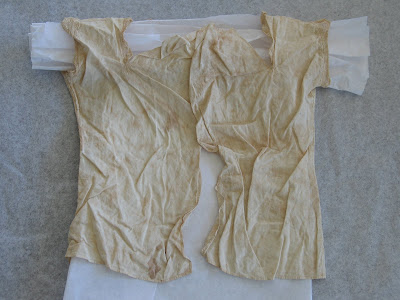Children's Clothing in the Victorian Era

Hallo my darling smunchkims. Today I want to take you back to the "Victorian era, when young children were seen and not heard, and to show you another wonderful piece of children's clothing from the Lynda Braid Collection. The image you see above is the cover of a Victorian magazine from 1884, called The Family Friend.

At this time ready made clothing was not as readily available as it is today, and Mother's were expected to sew their children's clothes, if they were not wealthy enough to employ servants to sew for them. The family Friend Magazine offered free patterns for children's clothes for home sewers to use, and here is a pattern for a child's pinafore.

Half a yard of diaper, this must have been the fabric used for early nappies, and the reason for their American name.

The insertion, is the lace.

The 1880's was the time of the Aesthetic Movement, a movement that encouraged healthy comfortable clothing.

Here is another piece of children's clothing from my cousin Lynda's collection. At first glance it seems to be of little interest, it is in poor condition with extensive discolouration and heavily creased from storage.

It is difficult to make out the shape as it is so creased.

It is when you look closely at this little piece that it starts to shine, look at the handwork on the shoulder seam, and the lace around the armhole. This garment was made in an age when women were highly skilled needle workers, the lace is hand made, and the pinafore is completely sewn by hand.

The technique used on the shoulder seam is wonderful don't you think? I have never seen a seam sewn like this before. If you are a wonderfully clever darling, and know more about this technique, its name, or when it was popular, please let me know. I am not sure what era this little garment is from, it seems early 1800's maybe even 1700's to me, but I am woefully inadequate and lacking in expertise, so if you can add from a deeper fountain of knowledge, please let me know.
I LOVE the shoulder seam! Such beauty in a clothing that really to an untrained eye would first look like nothing much. But maybe my eyes are not what they used to be, but I can not see what the man is saying to the boy in the pic, could you tell?
ReplyDeleteI was confused about that too... Can't believe parents all sewed for their children... You'd think they'd specialize... Like some would do all the tailoring for themselves and friends while others cooked or washed or whatever else slaves I MEAN women were obliged to do...
ReplyDeleteI suppose that was the advantage of a large family huh?
This comment has been removed by the author.
ReplyDeleteThis is a lovely example of an infant's first or open shirt. I would agree that this looks more like 19th century construction and trimming, particularly the fagoting stitches.
ReplyDeleteThanks Amanda for the information, its so nice to get your input.
ReplyDeleteThanks for sharing this. I write a site about making antique inspired dolls (maidatoday) and was researching clothing construction.
ReplyDeletethe fagoting type of stitch/trim i have in a 1962 clothing design book used as an insertion decoration on the bodice of a very cocktail dress, so it has been popular for quite some time. It is a pretty easy stitch to do as well. i found if you baste the seam, then do the decorative stitch, it makes it easier to keep them even. when you are done, pick out the basted area then press open and finish the raw edges as you choose. The stitch itself is pretty much just a X shape going from bottom left to top right. Then on the underside go from top right to bottom left. then in the area showing top left to bottom right, a very common bordering stitch for needlepoint. good luck if you decide to add it to any garment
ReplyDeleteI agree with all of the points keep up the good work.Thanks for sharing this informative blog with us..
ReplyDeletebaby clothes online & shabbos robes
This garment was made in an age when women were highly skilled needle workers, the lace is hand made, and the pinafore is completely sewn by hand.
ReplyDeleteBuy Baby Clothes Online UK